MAKING A
FIREPLACE
AUTHOR OF
BUNGALOWS, MAKING A ROSE GARDEN, ETC.
NEW YORK
McBRIDE, NAST & COMPANY
1913
The Project Gutenberg EBook of Making a Fireplace, by Henry H. Saylor This eBook is for the use of anyone anywhere at no cost and with almost no restrictions whatsoever. You may copy it, give it away or re-use it under the terms of the Project Gutenberg License included with this eBook or online at www.gutenberg.org Title: Making a Fireplace Author: Henry H. Saylor Release Date: September 19, 2008 [EBook #26670] Language: English Character set encoding: ISO-8859-1 *** START OF THIS PROJECT GUTENBERG EBOOK MAKING A FIREPLACE *** Produced by Markus Brenner and the Online Distributed Proofreading Team at http://www.pgdp.net (This file was produced from images generously made available by The Internet Archive/American Libraries.)
MAKING A | ||
|
AUTHOR OF | ||
|
NEW YORK | ||
Copyright, 1913, by
McBride, Nast & Co.
Published, January, 1913
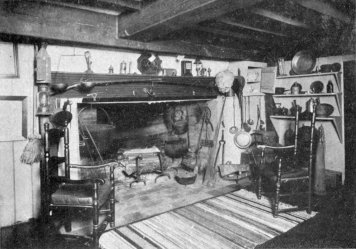 The fireplace of long ago, made large enough to accommodate
most of the kitchen’s pots and pans beside the fire
The fireplace of long ago, made large enough to accommodate
most of the kitchen’s pots and pans beside the fire
| PAGE | |
| Introduction | 1 |
| Construction | 7 |
| Miscellaneous Odd Forms | 22 |
| Facings and Mantels | 25 |
| Mending Poor Fireplaces | 31 |
| Fireplace Accessories | 36 |
| Building the Fire | 45 |
In a book of this kind there is no particular need for dwelling at length on the desirability of having a fireplace. That will be taken for granted. It is enough to say that in these days a home can scarcely be considered worthy of the name if it does not contain at least one hearth. There is some inexplicable quality in a wood fire that exerts almost a hypnotic influence upon those who eagerly gather about it. The smoldering glow of the logs induces a calm and introspective mood that banishes all the trivialities and distractions of the day’s work and gives one an opportunity to replenish his store of energy for the coming day.
The open fire, unlike most of the comforts that we demand in a modern home, [2]has been associated with the race as far back almost as the home itself. At first, of course, it was as a necessity and the development from that to a luxury has been an exceedingly slow one extending over the years down to the present time.
There are two forms of the open fire—a possible third one, the gas log, being a subject on which the less said the better. We have, therefore, a choice between the open fireplace designed for wood and the basket grate in which to burn coal, preferably cannel coal. This latter fuel is not nearly so well known in this country as in England where the scarcity of wood necessarily makes coal the more commonly used fuel. With our own abundance of wood, however, there will perhaps be little hesitancy in choosing the open fireplace rather than the basket grate for coal, although in certain cases, [3]for example an apartment where the flue has been built too small, or in a house where an available chimney offers only a small flue area for fireplace use, the basket grate will prove a welcome solution of the problem. Of course there is no excuse whatever for building a modern home with a chimney too small for the sort of fireplace you want, but where the chimney has already been built without this provision it may possibly be found that a small terra cotta flue lining may be inserted in the larger flue without seriously damaging the latter’s power of draft. In that event the addition of a basket grate fireplace to an old house would be an interesting possibility.
However fully we may appreciate the desirability of some sort of fireplace, there seems to be a rather widespread impression that the attainment is largely a [4]matter of chance. Too many home-builders have instructed their architects to provide a fireplace or two in the fond hope that the matter was then practically closed—a mere matter of time until they might be sitting before the fire’s cheerful glow. Too frequently the result has been a disappointment when the first few trials introduced into the room more smoke than heat or cheer. The reason for this is that there is a scientific basis for fireplace building which is frequently ignored absolutely by an over-confident and stupid mason. Where the work of building the home has been entrusted to an architect’s hands the latter usually appreciates the fact that the building of the fireplaces is liable more than any other part of the house to be taken into the mason’s own hands with, if he is not watched, disastrous results. Undoubtedly every mason [5]would resent most strongly any insinuation as to his lack of knowledge regarding fireplace construction. Each mason not only thinks that he knows how a fireplace should be built, but it is almost as general a rule that he feels that his particular method is the only correct one.
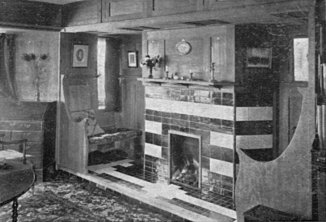 A modern English fire corner. Facing and
hearth have been worked out in a rather startling
contrast of tiles
A modern English fire corner. Facing and
hearth have been worked out in a rather startling
contrast of tiles
In view of this it might be well for any man building his own home to give some attention to the matter of his fireplaces, to insist on knowing how they are designed and to follow their construction throughout so that there is no chance for a blunder; and this chance is not so slight as might be supposed. In a house in which the author had carefully shown every detail of construction in the drawings, it was found when the building was nearly completed that the cast-iron throat flues, which ordinarily prevent any possible mistake of construction on the mason’s [6]part, had been put in reversed and it was necessary to tear down the whole face of the chimney breast in each case to replace them properly.
The matter of construction is not at all a complicated affair, as the next chapter will aim to show.
The chief difficulty in attaining a successful fireplace design does not lie in securing an abundant draft. In fact it is an easy matter to make a fireplace draw if the flue is large enough and the opening from the fire chamber into the flue unobstructed. There will never be any question of getting a roaring blaze the moment the fire is lighted.
This is, in a way, the type of fireplace that our Colonial ancestors built—great cavernous openings and generous flues, with the result that the more wood was piled upon the blaze the more they blistered their toes and at the same time chilled their backs. For it is evident that when we secure such a strong, unobstructed [8]current of hot air up the chimney, enough cool air to take its place must be drawn into the room through every opening and crevice. The result is a mighty draft that rushes past those unfortunate enough to be sitting about the fire and carries rapidly up the chimney almost all of the heat of combustion.
In the fireplace of our Colonial ancestors probably ninety per cent. of the heat was entirely lost, being carried up the chimney. However, cord wood was then to be had for the cutting.
We want a different sort of a fire in these days—one that will burn with a steady, constant blaze or glow, conserving most of its heat, which the back and sides of the fire chamber will reflect out into the room.
Such a fireplace will not necessarily be a large one. It is amusing to hear how [9]universally the demand goes up for large fireplaces—“great big fellows that will burn full cord wood.” It is hard to see just why this is. It may be based on the assumption that if a small fireplace is desirable a large one is more so. This is a fallacy that the architect and fireplace builder find it hard to dispel. There is no objection whatever to a large fireplace in a summer camp or informal shack of that sort. In fact a small one would in such a place be ridiculous, but when we come to our year-round living-room or dining-room or den, where the walls of the room are tight and the whole atmosphere quieter and more restrained, a large fireplace would be distinctly a disturbing element. Such a room as this, unless very poorly built, would not permit the in-take of sufficient air for the draft of a big fireplace, whereas in our slab cabin or log bungalow the conditions are quite different.
[11]For the ordinary room, therefore, a fair average size for the fireplace opening is three feet in width by two and a half feet high, with a depth half the width. From such a fireplace it is possible to get a maximum of heat with a minimum of draft.
There are two vital principles that should be observed in the design of any fireplace. One of these is the relation between the size of the opening into the room and the size of the flue itself. A cross-section of the flue—which incidentally should be kept the same throughout its extent—should be one-tenth of the area of the opening into the room. The second vital consideration is the introduction of what are known as a “smoke shelf” and a “smoke chamber.” The reason for constructing a fireplace [12]with these two features will appear more readily by reference to the diagram. This is drawn to show that when a fire is kindled on the hearth the warm air current, which is generated immediately, begins to rise through the throat (the opening between the fire chamber and the smoke chamber) and at once induces a down-draft of cold air. If the back of the fireplace were on the same continuous plane with the rear side of the chimney flue, this downward current of cold air would strike directly upon the fire itself and force smoke out into the room. The smoke shelf is built just where it will prevent this action. The sectional diagram does not perhaps make quite clear the shape of this smoke chamber, but the accompanying perspective outline sketch will indicate the fact that the throat and the smoke chamber at the bottom must [13]extend across the full width of the fire chamber. This width in the smoke chamber immediately diminishes in rising until it joins the flue at the flue’s own area.
The sectional diagram indicates a cast-iron damper built in the throat. This is not necessary, for it contributes nothing to the efficiency of the fire itself. Its one great advantage is that by furnishing the mason with an unalterable form, it forces him to build the throat properly rather than in one of the wrong ways that his own judgment might dictate. Such a cast-iron damper also forms a support for the flat arch of brick over the opening if bricks are used. If the damper is not built in, it is necessary to use an iron supporting bar to carry this flat arch. Then too, in case the damper is not used, there is lost the advantage of being able [14]quite readily to close the throat entirely, which is highly desirable in the summertime and frequently in the winter when the fireplace is acting too strenuously as a ventilator. If the cast-iron throat is not used, therefore, it will be well to lay an iron plate on the smoke shelf in such a way that it could be drawn forward across the opening to close it.
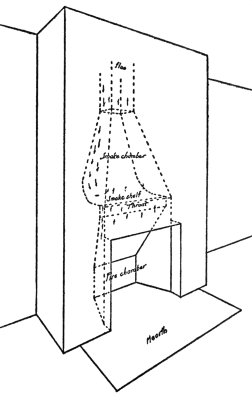 Perspective view of the fireplace, showing the
shape of the various parts as built without a
cast-iron throat damper
Perspective view of the fireplace, showing the
shape of the various parts as built without a
cast-iron throat damper
[15]There are other types of dampers, most of them patented and all of them aiming to provide an adjustable opening in the throat in some way. One or two of these have a knob or handle projecting through the brickwork of the arch, permitting the convenient adjustment of the damper from outside. As a general principle, however, it is well to choose the simplest possible device that will secure the desired result.
The terra cotta flue lining which is [16]shown in the sectional diagram is not absolutely necessary, of course, as it is a rather modern introduction and unnumbered fireplaces have served their purpose without it. There is no question, however, regarding its worth, for it provides a flue with smooth, regular sides that will not clog nearly so readily as an ordinary brick flue. Besides that, it has the advantage of permitting a thinner wall for the chimney. It is dangerous to build a chimney with a single four-inch thickness of brick between the flue and whatever may adjoin the chimney. Of course no wood should be allowed to come within an inch or two of the brickwork in any event, but with a single thickness of brick, unlined, there is always the danger that the mortar will crumble from a joint and leave an opening through which it would be an easy matter [17]for sparks or flame to do considerable damage. The introduction of a flue lining, however, into the chimney built in this way makes it entirely safe, provided the joints between sections of flue lining are carefully filled and made smooth with cement mortar.
The sectional diagram, it will be noticed, indicates a difference between the main back wall of the chimney, eight inches thick, and the brickwork laid inside the fire chamber to form the hearth and the back. The reason for this separation is that the rough brickwork of the chimney is always laid first as simply as possible, leaving the fire chamber with its sloping back and sides and the hearth to be filled in later with a better grade of brick or perhaps another kind. Frequently, also, tile will be combined with the brick finish as a hearth or facing.
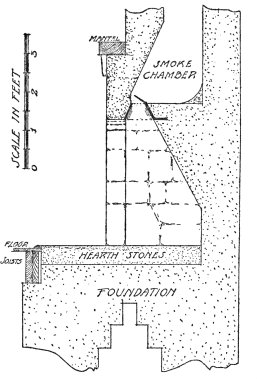 A cross-section showing the construction of a
large stone fireplace with slightly arched opening
A cross-section showing the construction of a
large stone fireplace with slightly arched opening
[19]A support for the hearth is usually obtained as indicated—by bringing what is called a “row-lock” or “trimmer” arch between the foundation masonry of the chimney and a pair of floor joists set out at the proper distance, depending upon the desired width of the hearth. While this is the customary method, occasionally a support is secured in some other way, such as corbeling out from the masonry foundation, or by extending two short projections of this masonry from the bottom up at either end of the hearth and throwing an arch across between these. Upon a bed of cement the hearth bricks themselves are laid, usually flush with the floor, although occasionally enough higher to permit a beveled molding strip to cover the joint between brick and floor more closely. In some cases the hearth itself is raised the full thickness [20]of a brick above the floor, as in one of the photographic illustrations shown.
The width of the hearth is ordinarily made about sixteen or eighteen inches beyond the face of the opening with the average size fireplace, twenty inches or even more with larger ones. This width should be increased, of course, if the opening is made considerably larger. The question of materials for the hearth and facing will be discussed in the next chapter.
The chimney itself should extend at least a foot or two above any nearby roof ridge and it should work without any cowl, whirligig or other device of that type on the top. There is no great objection to having the opening a horizontal one at the top of the chimney, although in that case if the flue is nearly straight throughout its course, some rain will find its way down to the hearth in a hard [21]storm. In most cases there is enough bend in the flue to prevent this, and if not it may be avoided by covering the top of the chimney with a stone and having the openings vertical ones on all four sides just under this.
All of the brickwork throughout chimney and fireplace should be laid in first-class cement mortar which consists of one part Portland cement to three parts clean, sharp sand. Although lime mortar was used in all brickwork up to recent years, it is not durable, particularly in the vicinity of heat.
There are many unusual forms of fireplace with which we are not particularly concerned. For example, one sees occasionally an opening shaped like an inverted heart or like an ace of spades. It is possible to make a fireplace of this kind work satisfactorily, but it is by no means certain that this result can be accomplished at the first trial nor that the fire will continue to work properly under all conditions. It is safer always to adhere to the established type of rectangular opening, or to depart from this only to the extent of having the top an arch of large radius. Whenever the top is permitted to vary more than a slight extent from the horizontal there is the danger of [23]having the smoke escape into the room at the top.
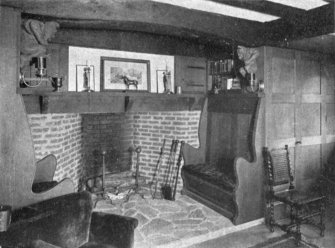 The inglenook seldom fails as a dispenser of home cheer.
Frequently the seats are placed too close to the fire
The inglenook seldom fails as a dispenser of home cheer.
Frequently the seats are placed too close to the fire
There is one other type that deserves special mention and that is the double fireplace, where two openings in adjacent rooms are served by a single flue between them. The only way in which this affects the two vital principles mentioned above is that the cross-section area of the flue should be one-tenth of the combined areas of the openings. The throat will in this case be in the middle of the chimney with the smoke shelf on either side of it. It is essential in a fireplace of this kind that there be no disturbing draft tending to pass through the opening from one room to the other.
Still another type which is even more rarely seen is the open fire in the middle of a room, such as may be desired occasionally in the lounging room of a large [24]club. Such an apparent anomaly could be secured by suspending a metal flue and hood from the roof, so that the lower edge of the truncated pyramidal form at the bottom would form the upper side of the fireplace “opening” at a convenient height above the hearth of brick, stone, tile or concrete. It is conceivable that an effective and thoroughly practical fireplace could be thus devised, having the flue and hood of wrought iron or copper, suspended and steadied by chains or bars from the ceiling and surrounding walls. In such a form the same principle of a fixed ratio between opening (here the entire perimeter of the hood multiplied by the distance above the hearth) and cross-section of flue would have to be observed, and here also it would be well to provide as fully as possible against the presence of disturbing drafts.
There is not a particularly wide choice of materials available for the finish of the hearth and fireplace. Stone, brick, cement and tile exhaust the possibilities, although with combinations of these we have all the variety that we could wish.
Stone is suitable only in certain environments—the informal shack or log cabin chiefly, though of course it is impossible to make any hard and fast rule in the matter.
Brick is almost never out of place. Perhaps it is the association with the fireplaces that have been built by our fathers and grandfathers, or perhaps it is the inherent worth and fitness of the material [26]itself that puts it forward as a first choice. Undoubtedly the practical consideration that it is easier and more economical to build has something to do with the matter.
Concrete is a newcomer in the field of fireplace facing and as yet it cannot be said to have shown any particular reason why it should displace the other materials. With the ordinary heat developed in an open fire of wood there is no likelihood of cracking the concrete facing if the material has been properly mixed and applied, although there seems to be a vague impression that this might be a real danger. The color of concrete gives it no particular recommendation, for it is one that remains unchanged by fire, though not unstained by smoke. Brick, on the other hand, and tile, have the very closest possible association with fire in the making, [27]which gives them a peculiar fitness for this purpose.
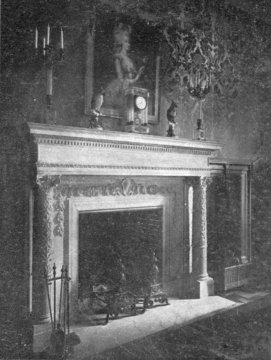 Caen stone or its clever representation in cement
serves well for the more formal type of mantel and
facing
Caen stone or its clever representation in cement
serves well for the more formal type of mantel and
facing
Tile, the last of the four materials, gives more latitude in design than any of the others, sometimes too much latitude we feel. If understandingly used, nothing could be more appropriate and attractive, but tile has been used so carelessly that somehow we have a feeling that the tiled fireplace is for show rather than for use. In any case, there is no question whatever regarding the unfitness of the glazed tiles which have made horrors of thousands of pseudo fireplace openings. It is only the mat-glazed or unglazed tiles that have any right to be used in such a place.
Since this little volume has for its subject the fireplace rather than the mantel, little need be said regarding the latter outward form, though there is no doubt [28]that a whole book on the subject might profitably be written. To touch upon the subject as lightly as space will permit, we can probably do no better than to suggest the obvious type of mantel for one or two of the more common architectural styles, and recommend that in other styles the architect be allowed sufficient latitude in design and expense to distinguish this important feature of hall, living-room, dining-room or library with the characteristics of the style he has worked out for the house itself.
The modern home along Colonial lines is perhaps the commonest problem, and incidentally the easiest, for the old models of delicately detailed white-painted wood mantels are so well known and so universally admired that modern reproductions along good lines and reasonable cost are easily obtained.
[29]For the English plaster or half-timber house the architect will doubtless design a special mantel, in scale and in harmony with the dark paneling and other architectural woodwork, probably with a paneled over-mantel if the cost is not too rigorously held down.
In a house which breaks away from the historic architectural styles, as so many of the stucco buildings of the day do, the mantel treatment offers particularly interesting possibilities. Frequently the mantel is done away with entirely and the chimney breast treated independently as a whole.
With the very informal type of summer home where a rough stone for facing and chimney is employed, the mantel treatment can hardly be kept too simple and unobtrusive in its rugged strength. A heavy log, planed to a smooth top surface [30]and resting on two projecting stone brackets, is frequently used with good effect. The chimney breast may be stepped back at the shelf height to form a narrow stone ledge, or the breast left without any shelf. Many simple variations with the informal brick chimney breast will occur to everyone. In general, with these summer shacks or bungalows, the fireplace is the chief architectural feature of the living-room and for that reason will stand a moderate amount of embellishment, but this latter should take the form of a slightly better finish of the materials used throughout the room rather than the introduction of more elaborate and costly ones.
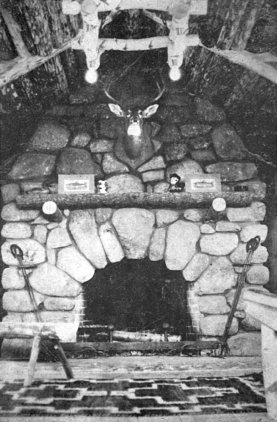 A fireplace and chimney breast of field stone,
chosen with care and laid with more than average
skill
A fireplace and chimney breast of field stone,
chosen with care and laid with more than average
skill
It is well enough to say just how a fireplace should be built so that it will work satisfactorily, but that does not go far in helping the man who has a fireplace that will not work. Frequently it is possible without any very great expense and trouble to correct a fireplace that has been improperly built. If one has in mind a clear comprehension of the few elementary principles of fireplace construction it will usually be an easy matter to determine the reason why a fireplace smokes or fails to draw.
The cross-section area of the flue is likely to prove the most common difficulty. Usually this cannot be seen from inside the fireplace, because of the narrow throat and the smoke chamber which in [32]some form may be above the shelf. If, therefore, the apparent essentials—such as shape of opening, narrow throat across the whole width, and preferably the slanting back—have been followed out it would be well to determine the area of the flue itself. To do this it will be necessary to reach the top of the chimney and, by lowering a weight on a line, find which flue leads to the fireplace in question. Its area at the top will in all probability be its area throughout. If the flue happens to be the only one in that particular chimney it may sometimes be determined more easily by counting the bricks in its two horizontal directions and in this way estimating what would probably be the inside flue. This conclusion is by no means sure, however, since the chimney may be built with eight-inch walls or it may be simply a four-inch wall with [33]the flue lining. To one with a knowledge of bricklaying, however, the way in which the chimney is laid up will usually indicate the size of the flue.
Having determined the size of the fireplace opening and the cross-section area of the flue itself, it will in many cases be found that the latter is too small for the former. The easiest way to remedy this difficulty naturally would be to decrease the size of the opening in the face of the fireplace. In order to check up the diagnosis, however, it would be well to fit a pair of thin boards to wedge fairly tightly into the opening at the top, one of which boards could be drawn down past the other one so that the fireplace opening may be decreased anywhere from six to twelve inches in height—using two six-inch boards. By testing the fireplace in action in this way it will be readily determined [34]by what amount the opening must be decreased. The boards then being removed, a wrought-iron curtain or decorative projecting hood of wrought iron or copper may be fitted permanently to the front.
It is possible, however, that the opening of the fireplace and the flue area are properly related, in which case it may be found that the trouble is due to the lack of a narrow throat and smoke shelf. This too could be constructed in the fireplace without disturbing anything outside, such as the mantel or chimney breast, unless the fireplace is not large enough to permit the addition of four inches of brick at the back. If it is not, it will be well to examine carefully the thickness of the wall at the back of the fireplace and if this is sufficient, part of it could be taken away where the slope of the back [35]joins the upright wall—about a foot above the hearth surface—and the sloping back built in from there up to form the throat. Or, to make perfectly sure of the result, the mantel itself could be removed—this is usually merely nailed to the plaster—and enough of the chimney breast taken down to permit the introduction of a cast-iron throat damper.
Just as a turkey dinner depends largely for its success upon the “fixin’s,” so the fireplace is in itself incomplete without its andirons and tools. To begin with the most nearly indispensable appurtenances, we must name the andirons—or, if the fuel is to be coal, then the basket grate. I have wondered sometimes why the philosophers have not hit upon the andiron as a particularly fitting subject for pleasurable rumination. There are so few things which combine to such a degree the purely utilitarian with the eminently decorative qualities. Most things which do combine the two in any real measure have been developed on the side of one at the expense of the other quality. Take man’s dress coat, for example, [37]the cut-away front of which, with the two buttons at the back, was designed to permit the gentleman to loop the skirts up to his waist when he mounted his horse. Or, take the modern lighting fixture with its little pan still waiting to catch the drip of the tallow beneath the flame, which has long since been displaced by gas tip or incandescent filament. How few things there are, after all, which ages ago—probably through a long evolution—were designed to meet a real need in the best possible manner and which still meet that need and combine true beauty with their usefulness. The wrought-iron shoe of a horse occurs to us, perhaps a ship’s anchor, a string-bow or an axe helve.
Some support is needed to raise the fuel so that the air may find a clear passage under and through it to the flames, and nothing could well be devised to serve [38]the purpose better than the pair of horizontal wrought bars, each with its single rear foot and its steadying front, the upper continuation of which serves to hold the burning logs in place.
One is not likely to go wrong in making a choice of andirons for any given type of fireplace. The simply turned brass patterns belong so obviously to the Colonial brick opening with its surrounding white woodwork; the rougher wrought-iron types are so evidently at home in the craftsman fireplace or the rough opening of stonework, that misfits are hardly possible.
Fortunately the old brass andirons of Colonial days have proven themselves fitted to survive, and many of them are still to be found in old cobwebby attics or in the more accessible shop of the dealer in antiques. One of these confided to me his [39]way of distinguishing the really old andirons from artificially aged reproductions: the old ones have the turned brass of the front post held in place by a wrought-iron bar that attaches to the horizontal member by a screw thread on the bar itself; on the modern examples this upright bar is drilled with a threaded hole into which an ordinary short screw engages through a hole in the horizontal member.
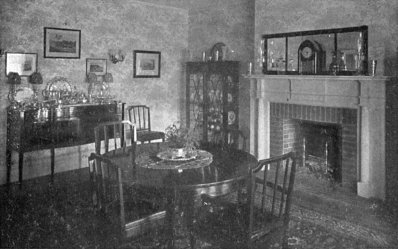 The good old dependable Colonial type, with its simple brick facing
framed by the delicately detailed white wood mantel
The good old dependable Colonial type, with its simple brick facing
framed by the delicately detailed white wood mantel
Next after the andirons in importance are the tools—the three most nearly essential ones being the poker, tongs and shovel. There is no need of saying that these should harmonize with the andirons and preferably be of brass if they are of brass; wrought iron if the andirons are of wrought iron. There are two ways of taking care of them—the ordinary method of using a stand which, if the tools are bought together, will probably [40]come with them; or in some of the fireplace types where the whole chimney breast is of brick, concrete or stone, sometimes a combination of three or more hooks is wrought in the same metal as the tools and fixed securely in the chimney breast at the side of the opening.
A brush for the hearth, although not so frequently seen, is exceedingly useful in sweeping back the ashes and small embers. Then there is the time-honored bellows, now hardly more than an ornament, for with a scientifically built fireplace it should never need to be called into action.
A screen of some sort comes nearer to being classed with the necessities than with the merely decorative accessories, for it is hardly safe to leave a fire or even the smoldering embers without some protection against the damage that is so [41]quickly caused by sparks. The usual type of screen is the woven wire one in several forms. Probably the most convenient type is that made up of a number of flat sections which fold upon one another into a compact mass which will not be in the way when not in use. In recent years, however, there is another sort of screen that is coming to be regarded with very high favor and that is the screen made up of glass in combination with other materials. There is the simple French screen of glass panes in a gilded frame, and there are wonderful possibilities for the employment of the craftsman’s skill in combining with plain or lightly tinted glass more decorative features in the way of stained glass and leading or in the combination of glass and metals.
The design of a fire screen depends, of [42]course, on the purpose it is intended to serve. If it is desired to secure a screen that will cut off the heat but not the light of the fire, the craftsman will work with larger areas of clear glass. On the other hand, it may be felt desirable to make a nearly opaque screen to cut off both light and heat. These, of course, are usually small rectangles on some sort of a pedestal and are not intended to take the place of spark screens.
A wood receptacle of some form is a convenient accessory, as one will avoid the task of carrying fuel up from the cellar or in from the woodpile whenever a fire is desired. There is a broad field from which to choose—brass-bound boxes of many sizes and forms, sturdy baskets and the metal wood baskets which are made for holding the logs themselves. There are those who prefer not to encumber [43]the vicinity of the fireplace with these rather bulky receptacles, but who find it convenient to have a box built in near by in the form of a window-seat or perhaps as a part of built-in bookcases. Two or three houses that I have known had a very simple rough dumbwaiter running from the cellar up into a window-seat. This could be loaded with fuel, hoisted into position and locked there until the fuel was needed.
There are two other fireplace accessories that we must not overlook, and these are the crane and the trivet. The crane is a very picturesque feature in a fireplace that is large enough to hold it comfortably, but it does seem unfortunate that in a great many fireplaces the crane is dragged in with the idea of making it a decorative feature but without any expectation of putting it to practical [44]use. There are fireplaces—in a summer camp, for example—where a crane could be put to good use. Used elsewhere it is too often merely an affectation.
The trivet is not nearly so well known as the crane and yet it might be put to use in a modern fireplace much more frequently. In England it is found in various ingenious forms, most of which show, however, some form of low stool which is stood upon the hearth, as near as may be convenient to the fire, to keep warm a teakettle or perhaps even a plate of toast. There are some rather interesting antique brass trivets to be found in many of the larger antique shops.
Ihave no doubt that the majority of the readers who have patiently found their way thus far through this little book will feel like closing it with a sigh of impatience at the sight of the chapter heading above. “Who doesn’t know how to build a wood fire? We might as well seek instruction as to the most approved method of striking a match!” But if you will bear with me for a moment I would say most emphatically that as a matter of fact very few people really do know how to build a fire. It is easy enough to assemble a bunch of newspapers, twigs, kindling and logs so that it is possible to start a fire, but perhaps you have noticed that while many fires are kindled few burn out. If you are [46]seeking for the greatest amount of comfort and enjoyment from your wood fire you will secure it only by sitting at the feet of that greatest of all teachers, experience, or perhaps more quickly by experimenting a bit with one or two of the simple expedients which I shall try to show are based on the wood fire’s way of working. While there are those who would not for worlds give up the pleasure of tinkering with the tongs and poker while the fire burns, it will perhaps not detract from this enjoyment if the tinkering is not actually the result of necessity to keep the logs burning. Fire-mending is a delightful recreation only when it is not imposed upon us by becoming an alternative to having the glowing embers become discouraged and give up the fight.
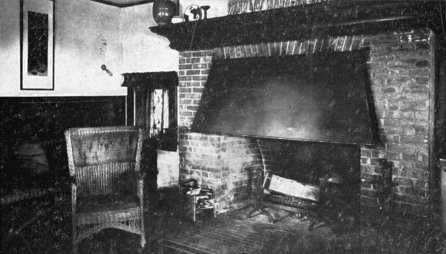 There is a splendid opportunity for home craftsmanship of a high order in
making the copper hood for an example of this type
There is a splendid opportunity for home craftsmanship of a high order in
making the copper hood for an example of this type
First of all, there is the need of having [47]fuel that is really dry. It is not essential that the woodpile be kept indoors, but it should at least have shelter above it and on three sides. The woodsheds of New England farmhouses offer a practical and efficient solution of the problem. Usually you will find these as an extension to the house, a shed open only to the south, in which the cord wood is piled neatly to the roof with sawn ends to the front. Two long logs are laid on the floor or ground, at right angles to the firewood, so as to encourage a circulation of air for drying.
In addition to the heavier logs which are cut to fit the fireplace opening, there should be almost an equal quantity of twigs, brush and smaller pieces, or else split kindling, to serve as starting fuel.
To lay a fire on the hearth, select first a heavy log which should be placed close [48]against the back of the fire chamber on the hearth and not on the andirons. This is the traditional “backlog.” It will serve through several fires and is intended mainly as a protection of the back brickwork. Stand the andirons with their rear ends close up against the backlog, and if the latter is of the best size its top will be well above the horizontal bars of the andirons. Now select a smaller log—preferably not a split piece—and lay it across the andirons. If a big [49]fire is desired, keep this log—the “forelog”—well to the front, just back of the andiron upright posts, leaving plenty of space between backlog and forelog for the main body of the fire. The distance between these two logs will govern the size of the fire. In this space put a few crumpled sheets of newspaper, some of the lighter twigs and small branches, and one, two or three logs or split pieces, as may be required to fill the space. The diagrams will make clearer this arrangement for a small fire or a large one.
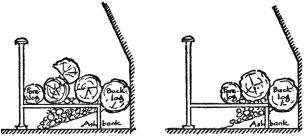 Section showing the arrangement of andirons
and wood for a large fire (at the left) and a
smaller one
Section showing the arrangement of andirons
and wood for a large fire (at the left) and a
smaller one
As the central portion of the fire burns away, keep the forelog pushed back against it, unless a less active fire is desired. It is well to remember that where one isolated log will not burn, two close together probably will, and a pyramid of three will do still better.
Many fireplaces show a tendency to [50]smoke only when first lighted; this is probably due to a cold chimney, and can usually be prevented or made less objectionable by burning a newspaper just under the throat, thus starting the proper action of the up and down drafts.
If it is possible for us to choose between various kinds of wood for our open fire fuel there is opened up one of the most interesting phases of the whole subject. To most people probably a wood fire is a wood fire, whether the logs be of cherry wood, pine, hickory or anything else. For the wood fire connoisseur, if we may call him by that name, there is no difficulty whatever in telling with a glance at the fire just what wood is burned. The crackle and explosive nature of hickory, the hiss of pine, the steady flame from cherry, the hot and rapid disintegration of sycamore, and the [51]steady and thorough combustion of soft apple wood soon become familiar characteristics to those who have the opportunity to lay the fire in variety. Then there is, of course, the fascination and the weird coloring in a driftwood fire—most spectacular of all but unfortunately denied to most of us.
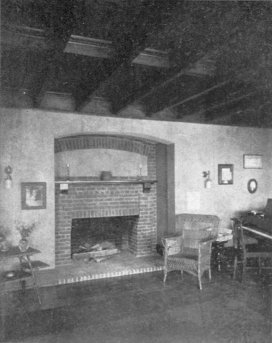 A simple and exceedingly effective recessed design
in brick and rough plaster. The hearth is
raised above the floor
A simple and exceedingly effective recessed design
in brick and rough plaster. The hearth is
raised above the floor
Finally, the most important factor of all in the management of a wood fire is an ample bed of ashes for its foundation. It is impossible for anyone who has not actually tried fires both ways to appreciate the immense advantage that a bed of wood ashes gives. It unquestionably doubles the fire’s efficiency in throwing heat out into the room, it halves the care and attention needed to keep the fire burning, and it increases beyond measure the beauty of a wood fire, when it is nearing its end, by rekindling itself with the [52]embers and keeping alive for a long time the quiet, dull red glow. Stop your ears to the importunities of the over-zealous housekeeper and steel yourself against the pricks of the conscience of cleanliness. If need be, fight for the retention of that bed of ashes. You can scarcely get it too large or too deep. The accumulation of two years is a priceless treasure. One of my own fireplaces has a bank that has to be depleted about twice a year to make room for the fire. A peck or two of the fine white powder is then carried out to bring joy to the rose garden.
To one who loves a wood fire and knows its possibilities the mention of such a thing as an ash-drop is as a red flag to a bull. Peace be to the ashes of the man who invented this easy method of robbing the hearth of half its charm. May he be forgiven it.
It is the intention of the publishers to make this series of little volumes, of which Making a Fireplace is one, a complete library of authoritative and well illustrated handbooks dealing with the activities of the home-maker and amateur gardener. Text, pictures and diagrams will, in each respective book, aim to make perfectly clear the possibility of having, and the means of having, some of the more important features of a modern country or suburban home. Among the titles already issued or planned for early publication are the following: Making a Rose Garden; Making a Lawn; Making a Tennis Court; Making a Water Garden; Making Paths and Driveways; Making a Poultry House; Making a Garden with Hotbed and Coldframe; Making Built-in Furniture; Making a Rock Garden; Making a Garden to Bloom this Year; Making a Garden of Perennials; Making the Grounds Attractive with Shrubbery; Making a Bulb Garden, Making a Garage, Making and Furnishing Outdoor Rooms and Porches; with others to be announced later.
End of the Project Gutenberg EBook of Making a Fireplace, by Henry H. Saylor
*** END OF THIS PROJECT GUTENBERG EBOOK MAKING A FIREPLACE ***
***** This file should be named 26670-h.htm or 26670-h.zip *****
This and all associated files of various formats will be found in:
http://www.gutenberg.org/2/6/6/7/26670/
Produced by Markus Brenner and the Online Distributed
Proofreading Team at http://www.pgdp.net (This file was
produced from images generously made available by The
Internet Archive/American Libraries.)
Updated editions will replace the previous one--the old editions
will be renamed.
Creating the works from public domain print editions means that no
one owns a United States copyright in these works, so the Foundation
(and you!) can copy and distribute it in the United States without
permission and without paying copyright royalties. Special rules,
set forth in the General Terms of Use part of this license, apply to
copying and distributing Project Gutenberg-tm electronic works to
protect the PROJECT GUTENBERG-tm concept and trademark. Project
Gutenberg is a registered trademark, and may not be used if you
charge for the eBooks, unless you receive specific permission. If you
do not charge anything for copies of this eBook, complying with the
rules is very easy. You may use this eBook for nearly any purpose
such as creation of derivative works, reports, performances and
research. They may be modified and printed and given away--you may do
practically ANYTHING with public domain eBooks. Redistribution is
subject to the trademark license, especially commercial
redistribution.
*** START: FULL LICENSE ***
THE FULL PROJECT GUTENBERG LICENSE
PLEASE READ THIS BEFORE YOU DISTRIBUTE OR USE THIS WORK
To protect the Project Gutenberg-tm mission of promoting the free
distribution of electronic works, by using or distributing this work
(or any other work associated in any way with the phrase "Project
Gutenberg"), you agree to comply with all the terms of the Full Project
Gutenberg-tm License (available with this file or online at
http://gutenberg.org/license).
Section 1. General Terms of Use and Redistributing Project Gutenberg-tm
electronic works
1.A. By reading or using any part of this Project Gutenberg-tm
electronic work, you indicate that you have read, understand, agree to
and accept all the terms of this license and intellectual property
(trademark/copyright) agreement. If you do not agree to abide by all
the terms of this agreement, you must cease using and return or destroy
all copies of Project Gutenberg-tm electronic works in your possession.
If you paid a fee for obtaining a copy of or access to a Project
Gutenberg-tm electronic work and you do not agree to be bound by the
terms of this agreement, you may obtain a refund from the person or
entity to whom you paid the fee as set forth in paragraph 1.E.8.
1.B. "Project Gutenberg" is a registered trademark. It may only be
used on or associated in any way with an electronic work by people who
agree to be bound by the terms of this agreement. There are a few
things that you can do with most Project Gutenberg-tm electronic works
even without complying with the full terms of this agreement. See
paragraph 1.C below. There are a lot of things you can do with Project
Gutenberg-tm electronic works if you follow the terms of this agreement
and help preserve free future access to Project Gutenberg-tm electronic
works. See paragraph 1.E below.
1.C. The Project Gutenberg Literary Archive Foundation ("the Foundation"
or PGLAF), owns a compilation copyright in the collection of Project
Gutenberg-tm electronic works. Nearly all the individual works in the
collection are in the public domain in the United States. If an
individual work is in the public domain in the United States and you are
located in the United States, we do not claim a right to prevent you from
copying, distributing, performing, displaying or creating derivative
works based on the work as long as all references to Project Gutenberg
are removed. Of course, we hope that you will support the Project
Gutenberg-tm mission of promoting free access to electronic works by
freely sharing Project Gutenberg-tm works in compliance with the terms of
this agreement for keeping the Project Gutenberg-tm name associated with
the work. You can easily comply with the terms of this agreement by
keeping this work in the same format with its attached full Project
Gutenberg-tm License when you share it without charge with others.
1.D. The copyright laws of the place where you are located also govern
what you can do with this work. Copyright laws in most countries are in
a constant state of change. If you are outside the United States, check
the laws of your country in addition to the terms of this agreement
before downloading, copying, displaying, performing, distributing or
creating derivative works based on this work or any other Project
Gutenberg-tm work. The Foundation makes no representations concerning
the copyright status of any work in any country outside the United
States.
1.E. Unless you have removed all references to Project Gutenberg:
1.E.1. The following sentence, with active links to, or other immediate
access to, the full Project Gutenberg-tm License must appear prominently
whenever any copy of a Project Gutenberg-tm work (any work on which the
phrase "Project Gutenberg" appears, or with which the phrase "Project
Gutenberg" is associated) is accessed, displayed, performed, viewed,
copied or distributed:
This eBook is for the use of anyone anywhere at no cost and with
almost no restrictions whatsoever. You may copy it, give it away or
re-use it under the terms of the Project Gutenberg License included
with this eBook or online at www.gutenberg.org
1.E.2. If an individual Project Gutenberg-tm electronic work is derived
from the public domain (does not contain a notice indicating that it is
posted with permission of the copyright holder), the work can be copied
and distributed to anyone in the United States without paying any fees
or charges. If you are redistributing or providing access to a work
with the phrase "Project Gutenberg" associated with or appearing on the
work, you must comply either with the requirements of paragraphs 1.E.1
through 1.E.7 or obtain permission for the use of the work and the
Project Gutenberg-tm trademark as set forth in paragraphs 1.E.8 or
1.E.9.
1.E.3. If an individual Project Gutenberg-tm electronic work is posted
with the permission of the copyright holder, your use and distribution
must comply with both paragraphs 1.E.1 through 1.E.7 and any additional
terms imposed by the copyright holder. Additional terms will be linked
to the Project Gutenberg-tm License for all works posted with the
permission of the copyright holder found at the beginning of this work.
1.E.4. Do not unlink or detach or remove the full Project Gutenberg-tm
License terms from this work, or any files containing a part of this
work or any other work associated with Project Gutenberg-tm.
1.E.5. Do not copy, display, perform, distribute or redistribute this
electronic work, or any part of this electronic work, without
prominently displaying the sentence set forth in paragraph 1.E.1 with
active links or immediate access to the full terms of the Project
Gutenberg-tm License.
1.E.6. You may convert to and distribute this work in any binary,
compressed, marked up, nonproprietary or proprietary form, including any
word processing or hypertext form. However, if you provide access to or
distribute copies of a Project Gutenberg-tm work in a format other than
"Plain Vanilla ASCII" or other format used in the official version
posted on the official Project Gutenberg-tm web site (www.gutenberg.org),
you must, at no additional cost, fee or expense to the user, provide a
copy, a means of exporting a copy, or a means of obtaining a copy upon
request, of the work in its original "Plain Vanilla ASCII" or other
form. Any alternate format must include the full Project Gutenberg-tm
License as specified in paragraph 1.E.1.
1.E.7. Do not charge a fee for access to, viewing, displaying,
performing, copying or distributing any Project Gutenberg-tm works
unless you comply with paragraph 1.E.8 or 1.E.9.
1.E.8. You may charge a reasonable fee for copies of or providing
access to or distributing Project Gutenberg-tm electronic works provided
that
- You pay a royalty fee of 20% of the gross profits you derive from
the use of Project Gutenberg-tm works calculated using the method
you already use to calculate your applicable taxes. The fee is
owed to the owner of the Project Gutenberg-tm trademark, but he
has agreed to donate royalties under this paragraph to the
Project Gutenberg Literary Archive Foundation. Royalty payments
must be paid within 60 days following each date on which you
prepare (or are legally required to prepare) your periodic tax
returns. Royalty payments should be clearly marked as such and
sent to the Project Gutenberg Literary Archive Foundation at the
address specified in Section 4, "Information about donations to
the Project Gutenberg Literary Archive Foundation."
- You provide a full refund of any money paid by a user who notifies
you in writing (or by e-mail) within 30 days of receipt that s/he
does not agree to the terms of the full Project Gutenberg-tm
License. You must require such a user to return or
destroy all copies of the works possessed in a physical medium
and discontinue all use of and all access to other copies of
Project Gutenberg-tm works.
- You provide, in accordance with paragraph 1.F.3, a full refund of any
money paid for a work or a replacement copy, if a defect in the
electronic work is discovered and reported to you within 90 days
of receipt of the work.
- You comply with all other terms of this agreement for free
distribution of Project Gutenberg-tm works.
1.E.9. If you wish to charge a fee or distribute a Project Gutenberg-tm
electronic work or group of works on different terms than are set
forth in this agreement, you must obtain permission in writing from
both the Project Gutenberg Literary Archive Foundation and Michael
Hart, the owner of the Project Gutenberg-tm trademark. Contact the
Foundation as set forth in Section 3 below.
1.F.
1.F.1. Project Gutenberg volunteers and employees expend considerable
effort to identify, do copyright research on, transcribe and proofread
public domain works in creating the Project Gutenberg-tm
collection. Despite these efforts, Project Gutenberg-tm electronic
works, and the medium on which they may be stored, may contain
"Defects," such as, but not limited to, incomplete, inaccurate or
corrupt data, transcription errors, a copyright or other intellectual
property infringement, a defective or damaged disk or other medium, a
computer virus, or computer codes that damage or cannot be read by
your equipment.
1.F.2. LIMITED WARRANTY, DISCLAIMER OF DAMAGES - Except for the "Right
of Replacement or Refund" described in paragraph 1.F.3, the Project
Gutenberg Literary Archive Foundation, the owner of the Project
Gutenberg-tm trademark, and any other party distributing a Project
Gutenberg-tm electronic work under this agreement, disclaim all
liability to you for damages, costs and expenses, including legal
fees. YOU AGREE THAT YOU HAVE NO REMEDIES FOR NEGLIGENCE, STRICT
LIABILITY, BREACH OF WARRANTY OR BREACH OF CONTRACT EXCEPT THOSE
PROVIDED IN PARAGRAPH F3. YOU AGREE THAT THE FOUNDATION, THE
TRADEMARK OWNER, AND ANY DISTRIBUTOR UNDER THIS AGREEMENT WILL NOT BE
LIABLE TO YOU FOR ACTUAL, DIRECT, INDIRECT, CONSEQUENTIAL, PUNITIVE OR
INCIDENTAL DAMAGES EVEN IF YOU GIVE NOTICE OF THE POSSIBILITY OF SUCH
DAMAGE.
1.F.3. LIMITED RIGHT OF REPLACEMENT OR REFUND - If you discover a
defect in this electronic work within 90 days of receiving it, you can
receive a refund of the money (if any) you paid for it by sending a
written explanation to the person you received the work from. If you
received the work on a physical medium, you must return the medium with
your written explanation. The person or entity that provided you with
the defective work may elect to provide a replacement copy in lieu of a
refund. If you received the work electronically, the person or entity
providing it to you may choose to give you a second opportunity to
receive the work electronically in lieu of a refund. If the second copy
is also defective, you may demand a refund in writing without further
opportunities to fix the problem.
1.F.4. Except for the limited right of replacement or refund set forth
in paragraph 1.F.3, this work is provided to you 'AS-IS' WITH NO OTHER
WARRANTIES OF ANY KIND, EXPRESS OR IMPLIED, INCLUDING BUT NOT LIMITED TO
WARRANTIES OF MERCHANTIBILITY OR FITNESS FOR ANY PURPOSE.
1.F.5. Some states do not allow disclaimers of certain implied
warranties or the exclusion or limitation of certain types of damages.
If any disclaimer or limitation set forth in this agreement violates the
law of the state applicable to this agreement, the agreement shall be
interpreted to make the maximum disclaimer or limitation permitted by
the applicable state law. The invalidity or unenforceability of any
provision of this agreement shall not void the remaining provisions.
1.F.6. INDEMNITY - You agree to indemnify and hold the Foundation, the
trademark owner, any agent or employee of the Foundation, anyone
providing copies of Project Gutenberg-tm electronic works in accordance
with this agreement, and any volunteers associated with the production,
promotion and distribution of Project Gutenberg-tm electronic works,
harmless from all liability, costs and expenses, including legal fees,
that arise directly or indirectly from any of the following which you do
or cause to occur: (a) distribution of this or any Project Gutenberg-tm
work, (b) alteration, modification, or additions or deletions to any
Project Gutenberg-tm work, and (c) any Defect you cause.
Section 2. Information about the Mission of Project Gutenberg-tm
Project Gutenberg-tm is synonymous with the free distribution of
electronic works in formats readable by the widest variety of computers
including obsolete, old, middle-aged and new computers. It exists
because of the efforts of hundreds of volunteers and donations from
people in all walks of life.
Volunteers and financial support to provide volunteers with the
assistance they need, is critical to reaching Project Gutenberg-tm's
goals and ensuring that the Project Gutenberg-tm collection will
remain freely available for generations to come. In 2001, the Project
Gutenberg Literary Archive Foundation was created to provide a secure
and permanent future for Project Gutenberg-tm and future generations.
To learn more about the Project Gutenberg Literary Archive Foundation
and how your efforts and donations can help, see Sections 3 and 4
and the Foundation web page at http://www.pglaf.org.
Section 3. Information about the Project Gutenberg Literary Archive
Foundation
The Project Gutenberg Literary Archive Foundation is a non profit
501(c)(3) educational corporation organized under the laws of the
state of Mississippi and granted tax exempt status by the Internal
Revenue Service. The Foundation's EIN or federal tax identification
number is 64-6221541. Its 501(c)(3) letter is posted at
http://pglaf.org/fundraising. Contributions to the Project Gutenberg
Literary Archive Foundation are tax deductible to the full extent
permitted by U.S. federal laws and your state's laws.
The Foundation's principal office is located at 4557 Melan Dr. S.
Fairbanks, AK, 99712., but its volunteers and employees are scattered
throughout numerous locations. Its business office is located at
809 North 1500 West, Salt Lake City, UT 84116, (801) 596-1887, email
business@pglaf.org. Email contact links and up to date contact
information can be found at the Foundation's web site and official
page at http://pglaf.org
For additional contact information:
Dr. Gregory B. Newby
Chief Executive and Director
gbnewby@pglaf.org
Section 4. Information about Donations to the Project Gutenberg
Literary Archive Foundation
Project Gutenberg-tm depends upon and cannot survive without wide
spread public support and donations to carry out its mission of
increasing the number of public domain and licensed works that can be
freely distributed in machine readable form accessible by the widest
array of equipment including outdated equipment. Many small donations
($1 to $5,000) are particularly important to maintaining tax exempt
status with the IRS.
The Foundation is committed to complying with the laws regulating
charities and charitable donations in all 50 states of the United
States. Compliance requirements are not uniform and it takes a
considerable effort, much paperwork and many fees to meet and keep up
with these requirements. We do not solicit donations in locations
where we have not received written confirmation of compliance. To
SEND DONATIONS or determine the status of compliance for any
particular state visit http://pglaf.org
While we cannot and do not solicit contributions from states where we
have not met the solicitation requirements, we know of no prohibition
against accepting unsolicited donations from donors in such states who
approach us with offers to donate.
International donations are gratefully accepted, but we cannot make
any statements concerning tax treatment of donations received from
outside the United States. U.S. laws alone swamp our small staff.
Please check the Project Gutenberg Web pages for current donation
methods and addresses. Donations are accepted in a number of other
ways including checks, online payments and credit card donations.
To donate, please visit: http://pglaf.org/donate
Section 5. General Information About Project Gutenberg-tm electronic
works.
Professor Michael S. Hart is the originator of the Project Gutenberg-tm
concept of a library of electronic works that could be freely shared
with anyone. For thirty years, he produced and distributed Project
Gutenberg-tm eBooks with only a loose network of volunteer support.
Project Gutenberg-tm eBooks are often created from several printed
editions, all of which are confirmed as Public Domain in the U.S.
unless a copyright notice is included. Thus, we do not necessarily
keep eBooks in compliance with any particular paper edition.
Most people start at our Web site which has the main PG search facility:
http://www.gutenberg.org
This Web site includes information about Project Gutenberg-tm,
including how to make donations to the Project Gutenberg Literary
Archive Foundation, how to help produce our new eBooks, and how to
subscribe to our email newsletter to hear about new eBooks.